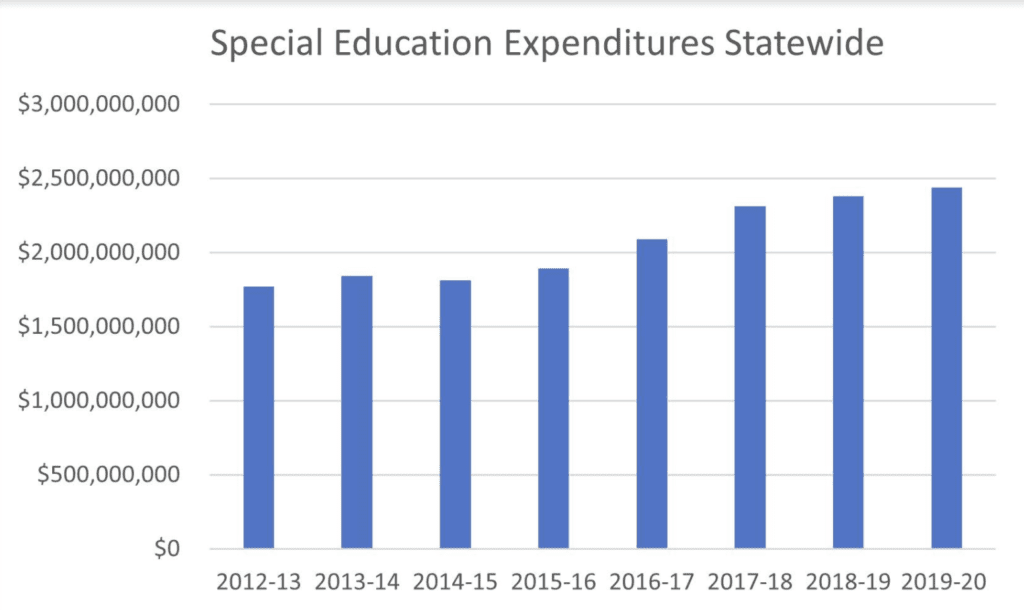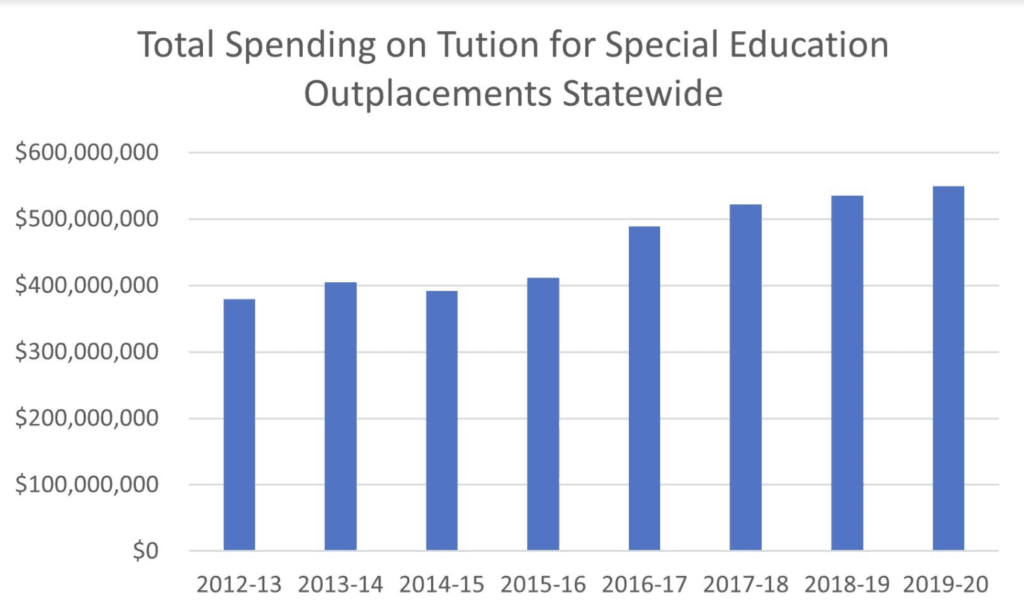A decade of rising costs for special education and increased student need are facing a staffing shortage that is frustrating efforts both by parents to provide suitable services for their children and by local districts needing a balanced budget.
According to state data, the total number of students in special education has increased from 63,482 in 2010-11 to 79,058 in 2020-21. Also increased is the percentage of students who are in need of special education — from 11.6 percent of the student population to 15.9 percent over the same time period.
One of the most dramatic increases is in diagnoses of autism, which increased by 79 percent between 2010-11 and 2020-21, according to state data. Autism now makes up 13.3 percent of students with disabilities in the state of Connecticut.

Dr. Rob Keder, a developmental-behavioral pediatrician at Connecticut Children’s Medical Center, said the increased diagnosis of autism could be a function of increased awareness among the people closest to the children.
“It could be parents are more aware. It could be that the primary care person is referring and screening more and … it could be that people are stronger advocates,” Keder said.
Tracy Sinclair, an assistant clinical professor of special education at the UConn Neag School of Education, agreed.
“I think when you have a greater understanding and a greater awareness of what type of disability it is, I think parents are asking those questions of their pediatricians or even school personnel,” she said.
Sinclair said that better diagnostic tools allow doctors to diagnose children with autism as early as nine months — allowing these children to receive services as soon as possible.
Keder also said that a diagnosis of autism can allow students to qualify for “intensive, evidence-based resources” that otherwise they wouldn’t be eligible for.
Sinclair said that one of the challenges with autism is the range of supports these students need.

“You’re really looking at broad categories of things like social interactions, communication skills, obviously academics, executive functioning skills and behavior. And so when you have so many different facets of the whole child that you need to provide support, a lot of times you have to involve a lot of related service providers,” said Sinclair.
Sinclair said these can include speech and language pathologists and behavioral specialists, which are in addition to the other special education personnel.
Jane Hampton-Smith, co-executive director at the Connecticut Parent Advocacy Center, a non-profit that said that many of the challenges that districts and parents face are related to communication.
“For example, if a family says, ‘My child doesn’t have any friends’, the school might say, ‘Your child needs social skills instruction’, but they’re not speaking in the same terms. So that can be a barrier for a lot of families,” she said.
A challenge for local schools
Finding the best education for a special needs student, according to Sinclair and Keder, is a highly individualized process. Some students — with the help of a range of support services — are able to remain in their home school district alongside their peers. Others are best served in separate private or public facilities — known as “outplacements.”
“The benefits to being within your home school with your neighborhood peers for social reasons is great, but if they’re not benefiting academically and advancing behaviorally and socially, then that could actually be more harmful for that student,” said Sinclair.
But the cost of these services presents a huge challenge to districts, particularly as the number of students with special needs makes up a growing percentage of the total student population.
Keder said he understood the challenge, and suggested that districts consider regionalizing special education services to bring costs down.
“I say that as a clinician, I try to be impartial … what does research or evidence suggest that a child needs? But we have to remember that a school district’s job is to figure out how to make a budget work for a diverse population,” said Keder.
Ian Neviaser, superintendent of Lyme-Old Lyme schools, said he believes that districts are trying more and more to provide services within the district rather than outplace pupils. He said that the cost to a district for a single outplacement can range from $60,000 to $400,000 each year based on the needs of a student.
The state does reimburse districts for a portion of their special education costs through two primary grants, one of which will reimburse districts for students who need services at significant cost. But the state will only reimburse costs that exceed 4.5 times a district’s per-pupil expenditures. That grant is also capped — meaning that even districts that qualify may not receive the full reimbursement.

In 2019-20, Lyme-Old Lyme outplaced two special education students, at a cost of about $523,000 in tuition, according to state data. The district was responsible for about $521,000 of that amount, according to the 2021-22 budget booklet.
Craig Cooke, superintendent of schools in Madison, said that while the administration tries to keep students in the district as much as possible, an outplacement is sometimes unavoidable based on the student’s needs. In 2019-20, Madison outplaced 19 students, which cost $2.56 million in tuition.
“The vast majority of the cost of the outplacement is borne by the district, so that’s definitely a concern,” said Cooke.
Cooke said one of the biggest cost drivers is that private facilities have tended to increase their rates between 5 and 10 percent yearly. He said that the increase in students with special needs has also meant the district has had to hire more special education teachers.
According to data from the state of Connecticut, Madison’s total special education costs were $9.7 million in 2012-13, roughly a fifth of the district’s total expenditures. In 2019-20, the costs increased to 13.7 million, or about 23 percent of the district expenditures. Over the course of those seven years, the number of special education students in the district increased from 352 to 382.
Paul Freeman, superintendent in Guilford, said that the district has managed to reduce the number of outplacements from 69 in 2012-13 to 39 this year by bringing more programs into the district, although the total number of students with special needs has remained steady.
But the costs continue to rise.
In Guilford, the costs for special education tuition, transportation and special services to the district rose from $3.4 million in 2010-11 to about $5.5 million in 2020-21, a number which Freeman thinks would be closer to $8 million if the district had not created programs that allowed these children to remain in the public schools. But, he said, the number of students in need of special education hovers at between 11 and 12 percent of the student population, and it does cost money to staff the in-district programs.
Freeman said that the district created a program for elementary-aged children with behavioral concerns, and also created an alternative high school program with small class sizes and high levels of support. He said the majority of special needs students in the district are elementary-aged children on the autism spectrum and high schoolers with social-emotional needs.
Freeman said he believed that keeping students with special needs in Guilford was the best way to provide them with the services they need, as well as sparing them long bus trips to outside schools. He said that non-disabled children would also benefit of having additional teachers, as well as counselors and social workers.
Keder said that having students with disabilities in the classroom is also critical in order for non-disabled peers to learn about acceptance.
“We do not want to seclude children with disabilities because the ADA was implemented for a reason,” said Keder. “If a child never meets another person with a disability, how will they learn how to acknowledge them as a person and human?”
The challenges of COVID
Kassidy Brown, executive director of the Light House, which runs two state-approved private outplacement facilities in Niantic, described the demand for their services as “cyclical.” He said he hadn’t seen a definitive increase in the last five to ten years.
But Brown did say that the program had experienced an increase in the demand for outplacements this past year — mainly, he said, because districts were experiencing staffing shortages and didn’t have the resources to meet students’ needs in-district. The number of students in their program, he said, increased by approximately 8 percent between this year and last year.
Jeffrey Newton, superintendent of schools in East Lyme, said his district was grappling with staffing shortages everywhere, and special education was no exception. He described the situation as “robbing Peter to pay Paul.”
School superintendents who spoke to CT Examiner for this story said that staffing shortages hadn’t increased the number of outplacements, but had forced their districts to make adjustments.
Cooke described shuffling paraprofessional staff, and Freeman said the shortage of substitute teachers had forced schools to make do, including in some cases combining classes. At times, he said, principals have had to step into instructor roles in the classroom.
The pandemic has had other effects as well. Keder said he thinks the pandemic has encouraged parents of special education students to worry even more about the progress of their children.
“We have to also recognize that with the lens of the pandemic on top of all this, that there’s going to be extra emotion, extra anxiety, extra FOMO [fear of missing out], for lack of a better term,” he said.
Keder said that the pandemic has revealed the problems in the current model for dealing with children’s emotional and behavioral health. He said it’s critical for schools to help children recognize and elaborate these emotions from a young age.
“We have to think about, how are we dealing with stuff early on? How are we teaching kids coping and emotional regulation skills instead of just handing them a smartphone when they’re tantruming as a toddler?” he said. “Helping families learn how to help their toddlers through emotions, helping school-aged kids learn how to walk through and talk through emotions will help — because if we’re not addressing it until by the time the kid’s a teenager and all of a sudden they’re thinking really dark thoughts about hurting themselves, we’ve missed a lot of opportunities.”
And for students who have suffered trauma, have a mental health condition or a behavior disorder, Sinclair said, the pandemic may have added stressors.
“Our kids have gone through a lot during this time of transition, of the remote learning and distance learning and back in schools and what their families have experienced with job loss or death in the family,” she said. “All of those things are going to affect kids at school. And if they have behavioral or emotional concerns, it could exacerbate that problem.”
Sinclair said this was especially a problem when there was a lack of supporting personnel, such as paraprofessionals and teacher’s aides.
“When schools don’t have that level of support for the special education teacher, then you don’t have enough adults in the classroom to provide enough one-to-one support or reduce that teacher to student ratio. And a lot of times that’s when behavioral problems can potentially crop up and become even more challenging in that setting,” she said.
Hampton-Smith said that the staffing shortages in the last year — whether bus drivers, special ed teachers or case managers — have been a major problem for the families that have come to her organization for help.
“Teams really need to sit down together and say, how can we meet this child’s needs despite not having that person because you can’t invent the person,” said Hampton-Smith. “So it’s really important for the team to discuss the critical. Missing piece and how that might be compensated for.”
Sinclair said she hopes that the focus on social and emotional learning that the pandemic prompted will continue long after the pandemic is over.
“When you think about students with autism, who do struggle with social interactions and often do have deficits in adaptive behavior skills or kids with emotional behavior disorders who struggle with interactions with their peers or self-regulation of their behaviors, more training and understanding of social emotional learning is also really important to help support those kids with disabilities who struggle,” she said.
Hampton-Smith said that the most important thing for families and districts when serving a special education student is strong communication.
“The research is very clear that when families in schools work together, students’ outcomes improve,” she said. “And so that’s always our fallback position — is when you guys work it out together, that kid’s going to do better.”

